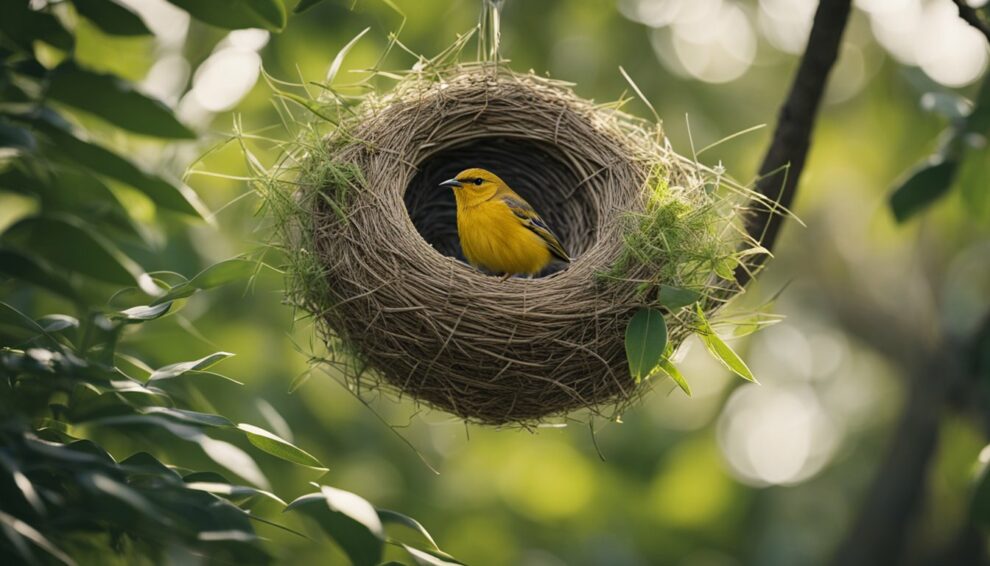The weaver bird is a small passerine bird that belongs to the Ploceidae family.
These birds are known for their incredible nest-building skills, which have earned them the title of “nature’s top architects.” Weaver birds have the ability to create intricately woven nests that rival any human feat of engineering.
Their nests are a source of inspiration for treehouse and hanging chair designers alike.

Weaver birds use a variety of materials, such as grass, twigs, and leaves, to create their nests.
They use their beaks and feet to weave these materials together, creating a sturdy and comfortable home for their young.
Weaver birds are skilled at creating different types of nests, depending on their species and environment.
Some weaver birds build spherical nests, while others build elongated nests that hang from tree branches.
The architectural wonders of the weaver bird are a testament to the incredible creativity and resourcefulness of nature.
These skilled nest builders are a marvel to behold, and their nests provide a safe and comfortable home for their young.
Whether you’re a bird enthusiast or simply curious about the natural world, learning about the weaver bird is sure to inspire awe and wonder.
The Art of Nest Construction
Weaver birds are renowned for their exceptional nest-building skills.
The intricate nests they create are marvels of avian architecture that are both resourceful and beautiful.
These nests are designed to provide the perfect shelter for the birds to lay their eggs and rear their young.
In this section, we will explore the art of nest construction by these skilled avian architects.
Materials and Tools
Weaver birds use a variety of materials to construct their nests, including grass, twigs, and leaves.
They use their beaks to weave and knot these materials together to create a sturdy and intricate structure.
The Baya weaver, for example, uses long strips of grass to create a nest that is shaped like a teardrop.
The buffalo weaver, on the other hand, uses twigs and sticks to create a nest that is shaped like a dome.
Design and Architecture
The design and architecture of weaver bird nests are truly remarkable.
The birds use their ingenuity to create nests that are both functional and aesthetically pleasing.
The nests are designed to provide the perfect shelter for the birds and their young.
They are also designed to be resourceful, using nature-centric elements to create a sustainable home.
For example, some weaver birds use spider webs to help bind their nests together, while others use feathers to create a soft and comfortable lining.
Location and Adaptability
Weaver birds are known for their adaptability, and this is reflected in the location of their nests.
They build their nests in a variety of locations, including trees, shrubs, and even on man-made structures such as buildings and power lines.
The location of the nest is often determined by the availability of resources and the need for protection from predators.
In conclusion, weaver birds are skilled nest builders that use their ingenuity and resourcefulness to create beautiful and functional homes for themselves and their young.
Their nests are a marvel of avian architecture, using a variety of materials and designs to create a sustainable and comfortable home.
Baya Weavers: Nature’s Skilled Architects

Baya Weavers, also known as Ploceus philippinus, are social birds that are commonly found in South Asia.
They are known for their exceptional craftsmanship in weaving intricate nests made of grass and twigs, which hang from the branches of trees.
These nests are a testament to nature’s artistic prowess and architectural ingenuity, and they are a marvel to behold.
Breeding Season and Nest-Building
Baya Weavers are known to breed during the monsoon season, which is from June to September in India.
During this time, the male Baya Weavers build their nests to attract females for mating.
The nests are woven from grass and twigs, and they are pendulous in shape with a narrow entrance at the bottom.
The Baya Weaver’s nest-building process is a sight to behold, as the male birds use their beaks and claws to weave the strands of grass and twigs together in a complex pattern.
The Role of Male Baya Weavers
Male Baya Weavers take on the primary role of nest-building, and they are known to be highly skilled in this craft.
They are also responsible for choosing the location of the nest, which is usually in a tree that is close to a water source.
Once the nest is complete, the male Baya Weaver will sing and dance around the nest to attract females for mating.
Predators and Security Measures
Baya Weaver nests are often targeted by predators such as snakes and birds of prey.
To protect their nests, Baya Weavers have developed several security measures.
One of these measures is the use of insulation, which is made of feathers, to keep the eggs warm and protect them from the cold.
The entrance tunnels of the nests are also designed to be narrow, which makes it difficult for predators to enter.
Additionally, the nests are often built in clusters, which provides safety in numbers.
In conclusion, Baya Weavers are truly nature’s skilled architects. Their nests are a testament to the beauty and ingenuity of the natural world.
The Baya Weaver’s nest-building process is a sight to behold, and their security measures are a testament to their intelligence and adaptability.
The Ecosystem and Conservation

Habitat and Biodiversity
Weaver birds are found in various parts of the world, including South Asia, Southeast Asia, and Africa.
They play an essential role in the ecosystem by providing nesting sites for other bird species and pollinating plants.
These social birds are known for their intricate and unique nest-building skills, which involve weaving together grass, fur, and other materials to create complex structures that provide shelter and protection from predators.
The weaver bird’s nest-building process is a fascinating example of how nature adapts to its environment.
They use a combination of materials that are readily available in their habitat, such as twigs, grasses, and leaves.
The nests are constructed with such precision that they can withstand harsh weather conditions and last for several years.
Weaver birds are also an important part of the biodiversity of their habitat.
They are not only a source of food for predators but also help to maintain the balance of the ecosystem.
Habitat loss due to human activities such as deforestation and landscape architecture has led to a decline in the population of weaver birds and other wildlife species.
Conservation Efforts
Conservation efforts are essential to protect the habitat and biodiversity of weaver birds.
Several organizations have taken initiatives to conserve the weaver bird population and their habitat.
These efforts include creating protected areas, promoting sustainable land use practices, and raising awareness about the importance of biodiversity conservation.
One such initiative is the Kadoorie Farm and Botanic Garden, which aims to protect the habitat of weaver birds and other wildlife species in Hong Kong.
The organization promotes sustainable land use practices and provides education and awareness programs to the local community.
Another example is the African Wildlife Foundation, which works to protect the habitat of weaver birds and other wildlife species in Africa.
The organization creates protected areas and promotes sustainable land use practices to conserve the biodiversity of the region.
Conservation efforts are crucial to protecting the habitat and biodiversity of weaver birds and other wildlife species.
By promoting sustainable land use practices and raising awareness about the importance of biodiversity conservation, we can ensure that future generations can enjoy the wonders of nature.
Frequently Asked Questions

How do weaver birds construct their intricate nests?
Weaver birds are skilled nest builders and use their beaks to weave grass, twigs, and other materials together to create their intricate nests.
They start by building a framework of grass and twigs, and then they weave in finer materials to create a cozy and secure home for their young.
They use their beaks to knot and weave the materials together, creating a tight and sturdy structure.
The weaving process is a skill that is passed down from generation to generation, and weaver birds have been perfecting their technique for millions of years.
What materials do weaver birds use to build their nests?
Weaver birds are resourceful and use a variety of materials to build their nests.
They use grass, twigs, leaves, and even spider webs to create their intricate structures.
Some species of weaver birds even use feathers and animal hair to line their nests, providing extra warmth and comfort for their young.
The materials used depend on the availability in the environment and the weaver bird’s preference.
How long does it take for a weaver bird to complete its nest?
It takes weaver birds several days to several weeks to complete their nests, depending on the size and complexity of the structure.
They work tirelessly, even during the hottest parts of the day, to ensure that their nests are secure and comfortable for their young.
Some species of weaver birds build communal nests, which can take months to complete and house hundreds of birds.
What are the unique features of a weaver bird’s nest compared to other bird nests?
Weaver bird nests are unique in that they are intricate and complex structures that are woven together using various materials.
They are also built with a roof, which provides extra protection from the elements.
Unlike other bird nests, weaver bird nests are built with a small entrance at the bottom, which helps to keep predators out.
Additionally, weaver birds are known to build their nests in colonies, creating a communal living space for their young.
How do the nests of weaver birds adapt to their environment?
The nests of weaver birds are adapted to their environment in several ways.
For example, some species of weaver birds build their nests near water, using reeds and other aquatic plants to create floating nests.
This adaptation helps to protect their young from predators and also provides easy access to food.
Other species of weaver birds build their nests in trees or bushes, using the surrounding foliage for camouflage and protection.
What role does nest-building play in the life cycle of a weaver bird?
Nest-building is a crucial part of the life cycle of a weaver bird.
It is during this time that the birds establish their homes and prepare for the arrival of their young.
The intricate weaving process also helps to attract potential mates, as it demonstrates the bird’s skill and dedication.
Once the nest is complete, the female weaver bird will lay her eggs, and both parents will work together to care for their young until they are ready to leave the nest.
Fun Fact: The nests of weaver birds can weigh up to 1 ton, making them some of the most impressive structures in the animal kingdom!









